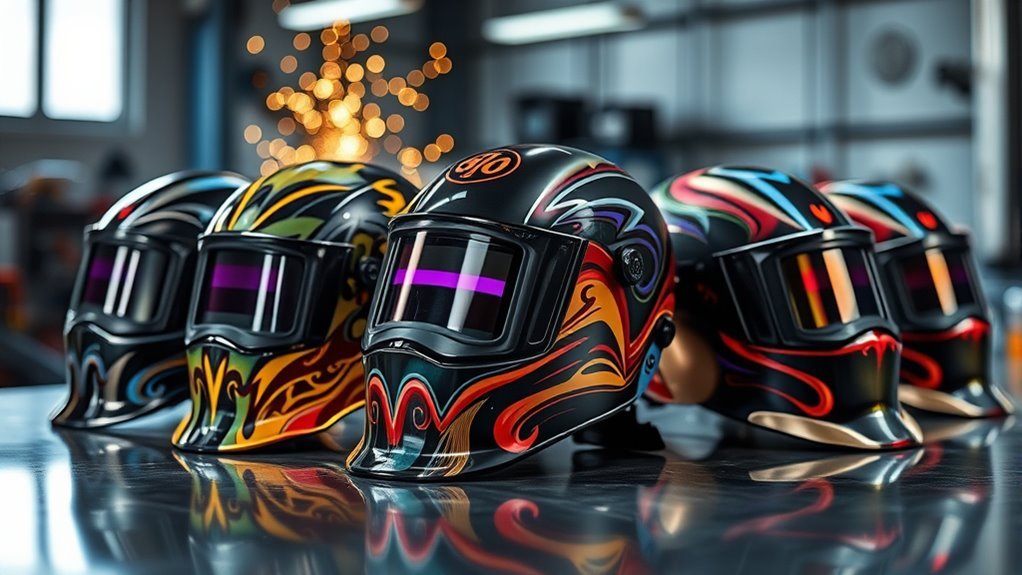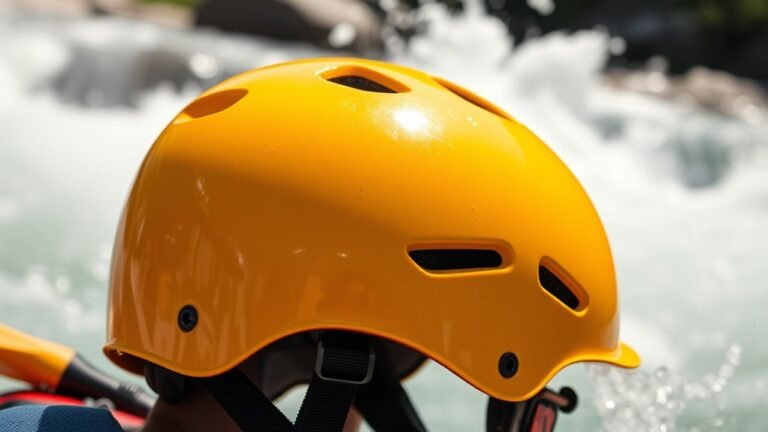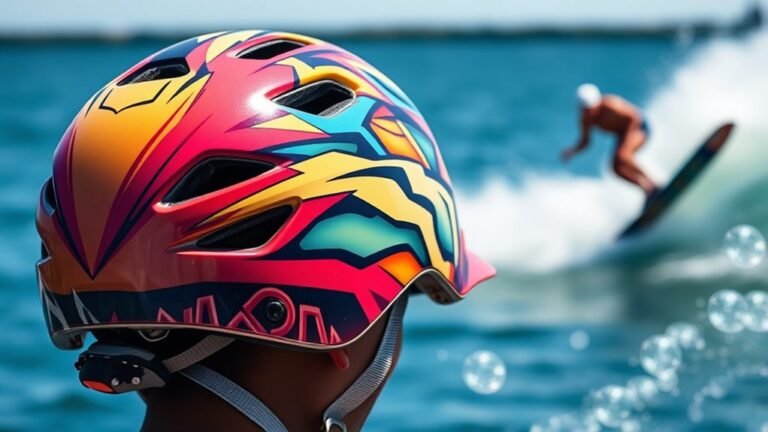Welding Helmets: Top Picks for Professionals
When choosing a welding helmet, prioritize protection against harmful UV and infrared rays and consider features like auto-darkening lenses for enhanced visibility and productivity. Look for comfort with adjustable straps and soft padding, as well as durability to withstand sparks and heat. Brands like Miller Electric and Lincoln Electric offer high-quality options tailored for professionals. Understanding how to maintain and adjust your helmet is essential for safety and performance—there’s much more to explore.
Importance of Choosing the Right Welding Helmet
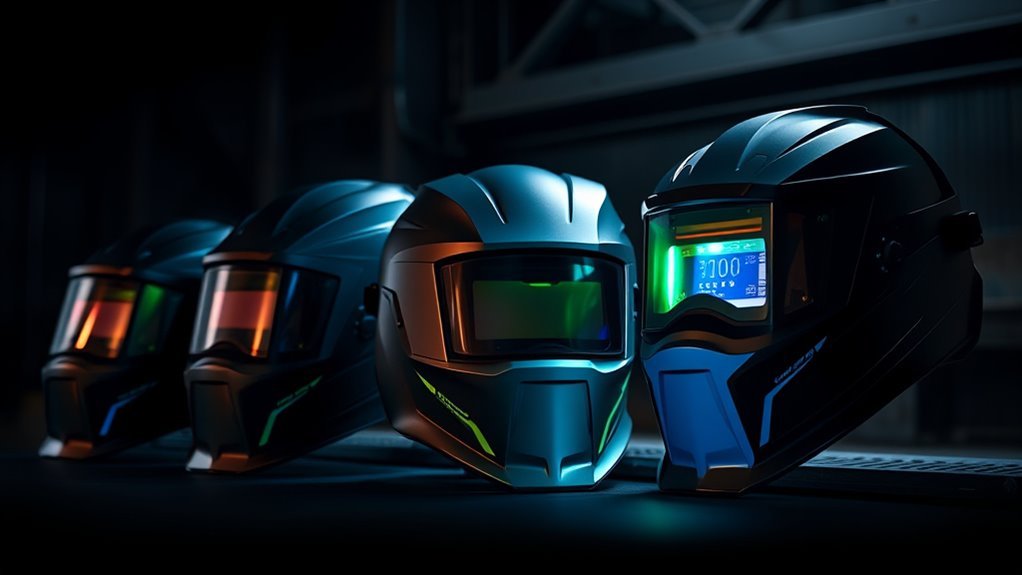
When you’re working in environments that demand precision and safety, choosing the right welding helmet isn’t just a matter of comfort; it’s crucial for protecting your vision and skin from harmful UV and infrared radiation. The wrong helmet can expose you to serious risks, including permanent eye damage and skin burns. Ensuring helmet safety means selecting a model that meets industry standards, providing adequate coverage and protection. Look for helmets with high-quality filters that block harmful rays while allowing clear visibility of your work. The right welding helmet not only safeguards your eyes but also enhances your overall performance, giving you the freedom to focus on your craft without worrying about potential hazards. Prioritize vision protection to maintain your health and freedom on the job.
Key Features to Look For
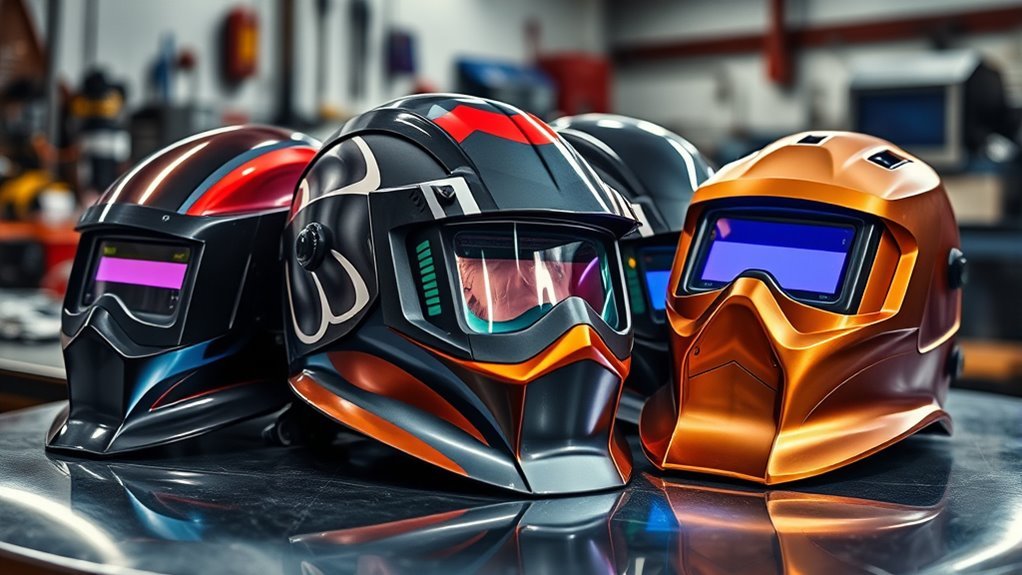
When selecting a welding helmet, you’ll want to prioritize lens technology options, ensuring you have the right shade and response time for your work. Additionally, comfort and fit are vital for extended use, as a poorly fitting helmet can lead to fatigue and distraction. Finally, consider durability and protection features to safeguard against sparks, heat, and UV exposure, which are essential for maintaining safety on the job.
Lens Technology Options
As you navigate the various lens technology options for welding helmets, it’s essential to understand the key features that can greatly impact your safety and performance. Selecting the right lens types and coatings will enhance your experience and protect your vision. Here are some vital features to take into account:
- Auto-Darkening: Adjusts shade based on arc brightness for ideal visibility.
- UV/IR Protection: Shields your eyes from harmful radiation.
- Anti-Fog Coatings: Reduces lens fogging, ensuring clear sight.
- Multiple Shade Settings: Offers versatility for different welding processes.
- Scratch Resistance: Enhances durability and longevity of the lens.
Choosing the right combination of these features can greatly elevate your welding experience while ensuring your safety on the job.
Comfort and Fit
Selecting the right lens technology is just one part of ensuring a safe and effective welding experience; comfort and fit are equally important. When choosing a welding helmet, look for adjustable straps that allow you to customize the fit to your head size. A secure fit prevents slippage during work, which can be vital for maintaining visibility and protection. Inner padding is another key feature to take into account; it should be soft and breathable to reduce fatigue during long welding sessions. Helmets with moisture-wicking properties can enhance comfort further, keeping you cool and dry. Ultimately, a well-fitted helmet not only enhances your comfort but also contributes to your overall safety, allowing you the freedom to focus on your craft.
Durability and Protection
While comfort is crucial, the durability and protection of a welding helmet are equally essential for professionals in the field. You need a helmet that can withstand various welding materials and environmental challenges while guaranteeing safety. Here are key features to look for:
- Impact Resistance: A robust shell to protect against falling debris.
- Heat Resistance: Materials that can endure high temperatures without warping.
- UV Protection: Filters that shield your eyes from harmful radiation.
- Scratch Resistance: Durable lenses that maintain clarity over time.
- Long Helmet Lifespan: Quality construction that guarantees longevity, reducing the need for frequent replacements.
Investing in a helmet with these features guarantees maximum protection, allowing you to focus on your work without compromising safety.
Passive vs. Auto-Darkening Helmets
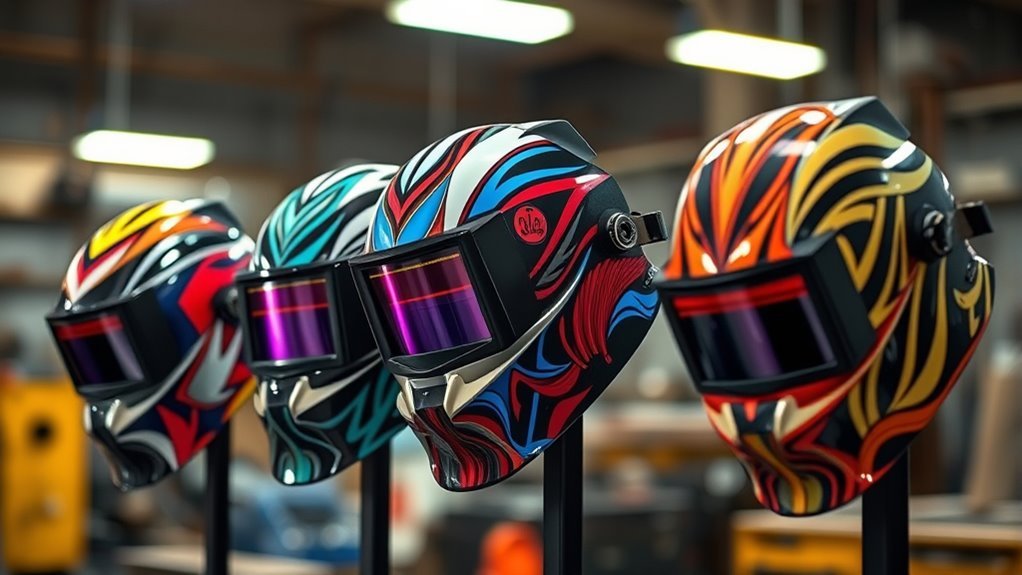
When it comes to choosing a welding helmet, you’ll often find yourself weighing the benefits of passive versus auto-darkening options. Passive helmets offer several advantages, including lower cost, simplicity, and durability. They provide a consistent shade, which can be beneficial for specific tasks. However, they require you to lift the helmet to see your work area, limiting your efficiency.
On the other hand, auto-darkening helmets bring significant benefits, such as immediate shade adjustment when striking an arc. This feature enhances your freedom to work without interruptions, increasing productivity and comfort. They also offer variable shade settings, catering to different welding processes. Ultimately, the choice depends on your welding style and personal preferences, balancing functionality with comfort.
Top Welding Helmets for Professionals
As you navigate the market for welding helmets, it’s vital to evaluate the top models that cater specifically to professionals. These helmets not only offer superior protection but also incorporate advanced technologies to enhance your welding experience. Here are some standout features to take into account:
- Welding helmet materials: Look for lightweight yet durable options like fiberglass or polycarbonate.
- Lens coating technologies: Anti-scratch and anti-fog coatings can greatly improve visibility.
- Auto-darkening performance: Quick response times guarantee eye safety without interrupting workflow.
- Comfort features: Adjustable headgear and padding provide a customized fit for long hours.
- Viewing area: A larger lens improves peripheral vision, essential for detailed work.
Selecting the right helmet can empower your craft, giving you the freedom to focus on what you do best.
Best Budget-Friendly Options
When you’re on a budget, it’s vital to identify essential features that guarantee safety and performance without breaking the bank. Consider factors like auto-darkening capabilities, comfort, and lens quality as you explore affordable brands that offer reliable options. This guide will help you navigate through cost-effective choices that don’t compromise on your welding needs.
Essential Features to Consider
While evaluating budget-friendly welding helmets, it’s crucial to prioritize essential features that guarantee safety and performance without breaking the bank. You’ll want to focus on aspects that enhance welding safety and utilize modern helmet technology effectively. Here are key features to take into account:
- Auto-Darkening Lens: Adjusts to varying light conditions for maximum visibility.
- Sensitivity Settings: Customizable to different welding processes for better control.
- Viewing Area: A larger field of view improves peripheral visibility and awareness.
- Weight and Comfort: Lightweight designs reduce fatigue during extended use.
- Durability: Robust materials guarantee longevity and protection from harsh environments.
These features assure you get a reliable helmet without sacrificing quality or safety.
Affordable Brands to Explore
Finding a reliable welding helmet that fits your budget doesn’t mean compromising on quality. Several brands offer affordable options without skimping on essential features like auto-darkening lenses and comfort. For instance, the Lincoln Electric Viking series provides excellent optical clarity and a lightweight design at a reasonable price. Similarly, the Miller Electric Digital Elite helmet combines advanced technology with a budget-friendly tag, ensuring you get quality assurance with every weld. Another notable mention is the Jackson Safety Insight, known for its durability and user-friendly interface. By exploring these brands, you can enjoy freedom in your welding projects while maintaining safety and performance, proving that quality and affordability can coexist seamlessly.
Premium Welding Helmets for Advanced Users
As you explore the world of advanced welding, opting for a premium welding helmet becomes essential for ensuring safety and maximizing performance. These helmets incorporate advanced features that provide superior protection and functionality. User reviews often highlight the following key attributes:
- Auto-Darkening Lens: Instantly adjusts to varying light conditions.
- Wide Viewing Area: Enhances visibility, allowing you to see your work clearly.
- Lightweight Design: Reduces neck strain during long sessions.
- Durability: Built to withstand extreme environments and heavy use.
- Adjustable Settings: Customizes sensitivity and delay for precise control.
Investing in a premium welding helmet not only boosts your performance but also provides peace of mind, letting you focus on your craft.
Comfort and Fit Considerations
When selecting a welding helmet, guaranteeing comfort and a proper fit is vital, as it directly impacts your concentration and overall performance. Look for helmets with high-quality padding materials that provide sufficient cushioning around the head and neck. This prevents discomfort during extended use and helps maintain focus on your work. Additionally, adjustable straps are essential for achieving a snug fit; they make certain the helmet stays securely in place, even during movement. A helmet that’s too loose can shift, causing distractions and potential safety risks. Consequently, prioritize models that allow for customization in fit, enabling you to work freely and effectively, no matter how demanding the task at hand. Comfort and fit are key to your welding success.
Maintenance and Care for Your Helmet
To guarantee your welding helmet operates at its best, regular cleaning is essential; dirt and grime can impair visibility and safety. You’ll also need to replace the lens periodically to maintain protection from harmful radiation. Understanding these maintenance practices can greatly extend the life of your helmet and enhance your welding experience.
Regular Cleaning Practices
Regular cleaning of your welding helmet is essential for maintaining peak performance and guaranteeing your safety on the job. To keep your helmet in top condition, establish a cleaning frequency that suits your work environment—daily or weekly, depending on usage. Use appropriate cleaning solutions to avoid damaging the materials.
Here are some best practices:
- Use a soft cloth to gently wipe the exterior.
- Clean the lens with lens-specific solutions to prevent scratching.
- Inspect the visor for cracks or wear after each use.
- Remove dust and debris from vents to guarantee proper airflow.
- Store your helmet in a protective case when not in use.
Regular maintenance keeps your gear reliable and your vision clear.
Lens Replacement Tips
Maintaining the integrity of your welding helmet goes beyond routine cleaning; lens replacement is a key aspect of guaranteeing peak performance and safety. You should monitor your lens for scratches, cracks, or discoloration, as these can impair visibility and increase risks. Generally, a lens replacement frequency of every 6 to 12 months is advisable, depending on your usage intensity. Ascertain you’re aware of lens compatibility with your specific helmet model to avoid fitting issues. When replacing, opt for high-quality lenses that meet industry standards, as this enhances durability and protection. Remember, regular checks and timely replacements not only promote safety but also contribute to your overall welding experience, allowing you the freedom to focus on your craft.
Popular Brands and Their Offerings
As you explore the landscape of welding helmets, you’ll find that several brands stand out for their innovative designs and advanced features tailored to professional needs. A brand comparison reveals unique offerings that cater to various welding applications. Here are some top picks:
- Miller Electric: Known for high-quality optics and durability.
- Lincoln Electric: Offers a range of auto-darkening helmets with customizable settings.
- ESAB: Features lightweight designs, ideal for extended use.
- 3M: Combines comfort with advanced safety technologies.
- Harbor Freight: Budget-friendly options without compromising on essential features.
Product reviews often highlight these brands’ reliability, comfort, and performance, making them popular choices among professionals who value both protection and freedom in their craft.
How to Properly Use and Adjust Your Helmet
Understanding how to properly use and adjust your welding helmet is essential for maximizing its protective features and guaranteeing comfort during long hours of work. Start by making necessary helmet adjustments for a snug fit. The headgear should be adjusted so the helmet sits securely without pinching your forehead. Next, verify proper positioning of the lens; it should align with your eyes to provide ideal visibility while protecting against harmful rays. Check the side and top settings to avoid gaps that could expose your skin. Finally, practice wearing the helmet during a brief session to confirm comfort and effectiveness. These adjustments will not only enhance safety but also allow you to work freely and efficiently.
Frequently Asked Questions
What Is the Average Lifespan of a Welding Helmet?
The average lifespan of a welding helmet is about 5 to 7 years, but it can vary based on several factors. If you follow proper helmet maintenance tips, like cleaning the lens and guaranteeing a snug fit, you can extend its life. Additionally, exposure to extreme conditions, like high heat or chemicals, may shorten its lifespan. Regularly inspect your helmet for wear and tear to guarantee maximum protection while you’re working.
Can I Use a Welding Helmet for Other Tasks?
Yes, you can use a welding helmet for other tasks. Its versatile applications include grinding and cutting operations, where eye protection is essential. However, consider helmet alternatives designed specifically for those tasks, as they may offer better visibility and comfort. While a welding helmet provides excellent protection from sparks and debris, make certain it meets the needs of your specific project to maintain safety and effectiveness. Always prioritize the right gear for the job at hand.
How Do I Choose the Right Size Helmet?
To choose the right size helmet, you’ll want to prioritize size adjustment and helmet fitting. Measure the circumference of your head just above the ears, then consult the manufacturer’s sizing chart. Look for helmets with adjustable headbands for a snug fit. A well-fitted helmet guarantees comfort and maximum protection while you work. Don’t compromise on size; a perfect fit grants you the freedom to focus on your tasks without distractions.
Are There Specific Certifications for Welding Helmets?
Yes, there are specific certification standards for welding helmets, primarily set by organizations like ANSI and ISO. When choosing a helmet, consider features such as the lens shade range, optical clarity, and impact resistance, which should meet these standards. Ensuring your helmet is certified not only guarantees quality but also enhances your safety and performance while welding. Don’t compromise on these features; they’re essential for your protection and comfort on the job.
How Do I Store My Welding Helmet Properly?
To keep your welding helmet in tip-top shape, think of it as a prized possession. Use these helmet maintenance tips: store it in a cool, dry place, away from direct sunlight. Consider a padded bag or protective case as your storage solution to prevent scratches and damage. Regularly clean the lens and inspect the headgear for wear. By taking these steps, you’ll guarantee your helmet lasts longer and performs at its best.
